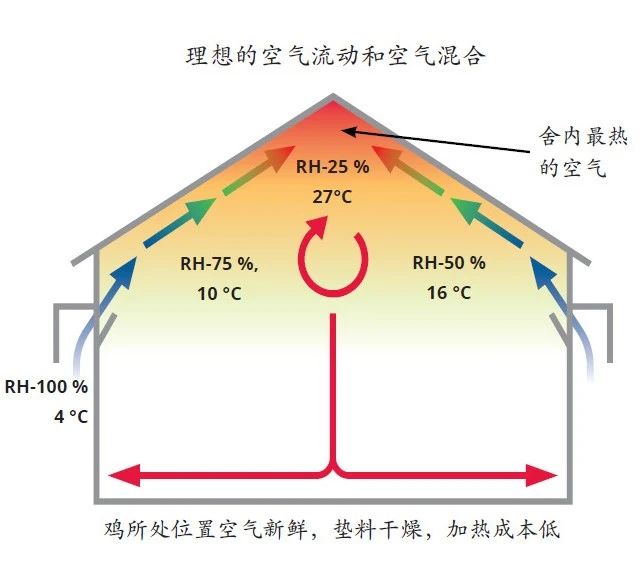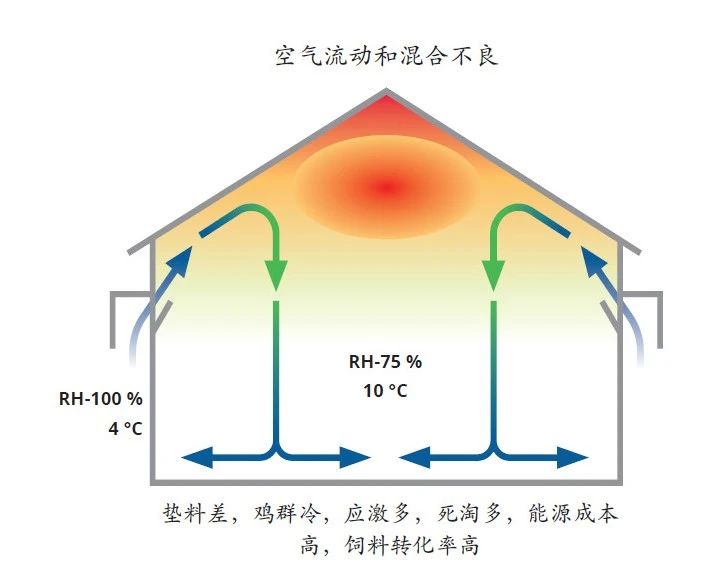Ventilation needs to be of sufficient and effective capacity throughout the life cycle of the flock. Below is an example of the calculation of the number of fans required. The ventilation calculation method is only indicative. Daily adjustments should be made based on air quality and humidity. It should be adjusted daily according to air quality and humidity. The range and capacity of fans for circulating ventilation will increase over time until all installed ventilation fans are used up.
Calculate the number of fans required for ventilation of a typical tunnel ventilated chicken house
Sample fan
The fan capacity used in the example is rated for negative working pressure of 25pa
Exhaust fan or sidewall fan: 900 mm, efficiency of 340 m3 / min
Air exchange capacity: 0.3 to 0.60 cubic meters/minute per square meter of building area
Note: Ideally, these fans should be of fixed capacity without changing.
A fan capacity of 2 cubic feet per square foot area is required only in cold climates.
Chicken coop example
Coop size: 150 m long, 14 m wide, average height 2.88 m
Average height = 2.5 m + (0.5 × 0.75 m) = 2.88 m
Chicken house building area: 150 meters × 14 meters = 2,100 square meters
(chicken house building area X air change rate) ÷ actual fan capacity = number of fans required
The number of ventilation fans required when the air exchange efficiency is 0.3 ~ 0.6m³/min per square meter
2100m²× per square meter building area 0.3 ~ 0.6m³/min = 630 ~ 1260m³/min
630 ~ 1260÷340m³/min = 1.85 ~ 3.70 or 2 ~ 4 fans
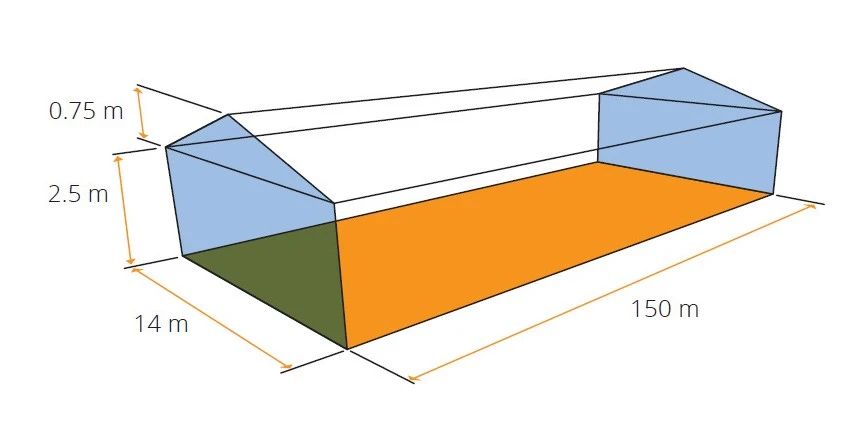
Negative pressure - a key requirement for ventilation
An effective way to complete air distribution for ventilation is to use a negative pressure ventilation system. The negative pressure of the inlet and the opening of the inlet should be adjusted to ensure that the incoming air jet can adhere to the ceiling and reach the apex of the heat accumulation in the building.
The table (below) can be used as a reference guide for determining the required negative pressure. The negative pressure chosen depends on the width of the coop, the distance the air must travel after entering the coop from the air intake, and the outside temperature. When the outside temperature is below 5°C, it is necessary to increase the negative pressure and opening size of the air intake. Whether the incoming air can adhere to the ceiling depends on the temperature difference between indoor and outdoor. Always use a smoke test to ensure that the intake reaches the center of the coop.
The smoke test can only be carried out when the outdoor temperature is significantly lower than the indoor temperature and there is no wind.
In a coop with obstructions such as purlins or wire tubes that interrupt the incoming air flow, a smooth solid ramp of about 3 meters is required at the air intake/small window.
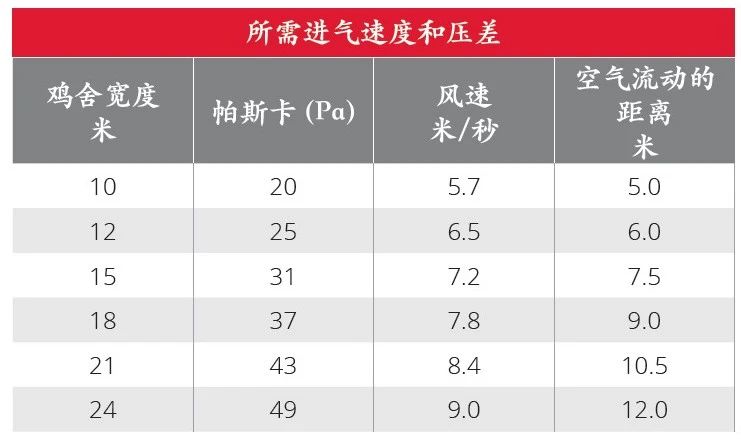
Note: When the air inlet/window is installed in a coop with a lower side wall position, the negative pressure and the opening of the air inlet/window need to be increased accordingly to ensure that the air inlet jet reaches the center of the coop. Especially in the case of low external temperatures, it is particularly important.
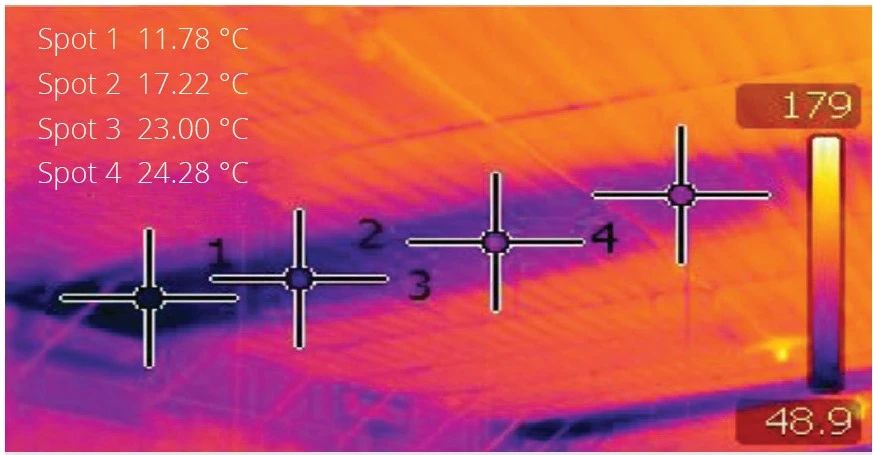
The infrared image shows the correct flow of cold air into the house through the air intake/small window. When the air reaches the center of the coop, the ceiling temperature at points 1 to 4 gradually increases.
Animal welfare Tips
In addition to daily temperature monitoring, the behaviour, activity and distribution of the flock within the house are assessed. If the flock feels hot or cold, they will behave differently than a comfortable flock. For example, if cold air comes in through the air intake, does not mix on the ceiling, and falls directly onto the floor, the flock will preferentially stay away from this cooler area and may huddle or group in a more central location within the house.
Air intake/small window management and installation
The air inlet/small window can be said to be an important part of the chicken house ventilation system. The location and design of the air intake will have a significant impact on the direction in which cold air enters. During the cool season, the fresh air that enters the house (cooler and heavier) mixes with the warm, dry air before it reaches the height of the chicken's back. At the same time as mixing, the temperature of the incoming air increases and the humidity decreases. The air intake/small window is a tool that can initially manage the air intake. With them, the airflow can be directed so that the air gains heat and reduces humidity as it flows into the center of the coop. For every 11°C increase in temperature, the relative humidity decreases by half.
A common consequence of poor air intake management is the humidification and caking of bedding, mainly along the sidewalls. A well-designed air intake should be completely closed and sealed when the fan is turned off. When opened, air can only enter from the top of the inlet, not from the side or bottom of the inlet. Air intakes that leak from the sides and bottom can divert cold air to the floor, causing cold stress and condensation.
The size of the air intake opening should be controlled by negative pressure in order to maintain a constant airflow at different fan capacities. When a wire rope is used to operate the air intake, special attention needs to be paid to the nylon rope used to close the air intake. Because the rope will stretch, it is easy to cause uneven opening. If the air inlet is not completely closed, it will cause a loss of heat and energy, especially in windy weather. When installing air intakes, use steel rods with a diameter of 8 mm.
Air intakes for ventilation need to have openings large enough to achieve the required static pressure and intake volume. Depending on the design of the intake, at least 2.5cm to 5cm openings need to be opened to ensure that the cold air jet adheres to the ceiling and leaves the ceiling near the center. In cold weather, be sure to smoke test the coop or attach a row of ribbon to the ceiling from the front of the air intake to the center of the coop. Place these straps near the air inlet of the operation room for easy observation.
